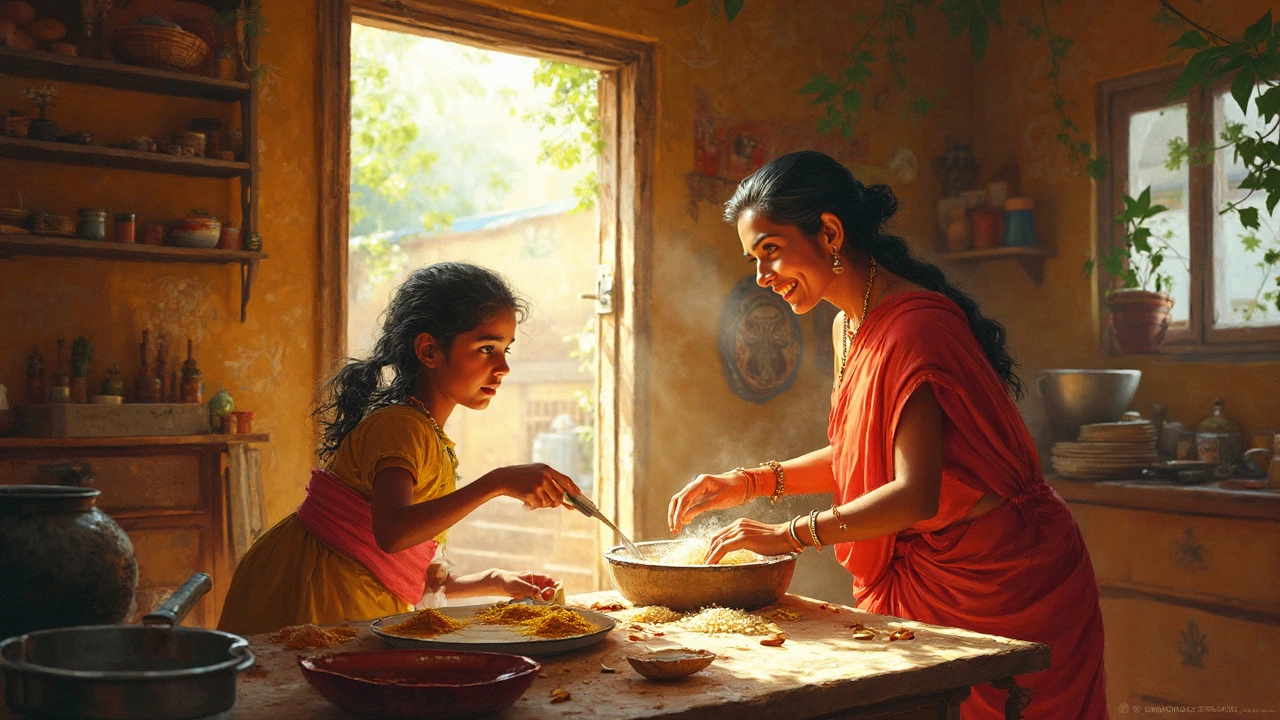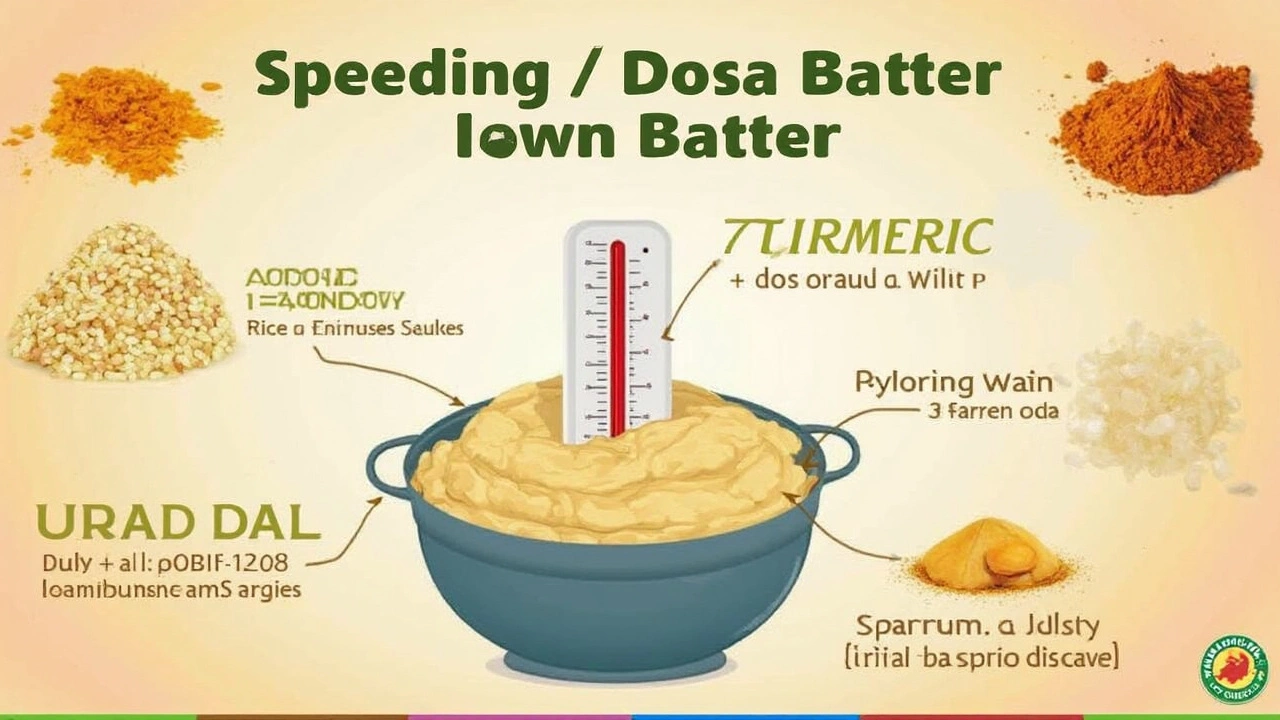Quickly Ferment Dosa Batter Without Yeast
 Feb, 15 2025
Feb, 15 2025
Ever tried making dosa batter at home and felt like it takes forever to ferment? It can be frustrating, especially when you're ready to enjoy that crispy, flavorful dosa but the batter isn't quite there yet. But guess what? You don't really need yeast to speed things up!
Fermentation is all about the dance between the ingredients and their environment. The right temperature can work wonders, turning slow fermentation into a rapid process. If your kitchen is a bit chilly, you might try keeping the batter near a warm spot, like near the oven or a sunny window.
Another nifty trick is using fenugreek seeds — yes, those tiny seeds can do wonders not just in flavor but also in fermenting. Just a small handful ground with your rice and dal can make a noticeable difference.
We’re not diving into rocket science here, just simple tweaks that make a big change. Stick around, and let's break down how you can whip up dosa batter faster and easier, so those fresh dosas are just a step away!
- Understanding Fermentation Basics
- Ingredients That Speed Up Fermentation
- Temperature and Environment's Role
- Non-Yeast Fermentation Techniques
- Practical Tips for Perfect Dosas
Understanding Fermentation Basics
If you've ever wondered how dosa batter transforms from a mere mix of rice and dal to a bubbly, airy concoction, you're diving into the world of fermentation. The magic happens when natural airborne yeast and bacteria kick in, hosting a party in your batter. They feed on the sugars released by the rice and dal, causing the release of carbon dioxide — this is what makes the batter rise.
The Role of Ingredients
A critical component in this mix is time and temperature. With the right balance, your fermentation speeds up. For instance, warm conditions are a friendly environment for these microorganisms. But that's not all! Fenugreek seeds make an intriguing guest. Besides imparting flavor, they contain natural enzymes that help break down complex carbohydrates, accelerating fermentation.
Breaking Down the Science
Let's not forget, not all fermentation is equal. Acidic fermentation, which is typical for dosa batter, enhances flavors while maintaining a healthy mix of probiotics. It's the same science used in making yogurt, and it's been around for centuries.
Here's a quick peek into a typical fermentation cycle:
- Day 1: Mix rice and dal, soak them, and blend to a smooth batter.
- Hour 8-12: Keep the batter in a warm place; you may see tiny bubbles starting to appear.
- Hour 24: The batter doubles in size, and you now have a ready-to-make dosa batter!
Fun fact: In ideal conditions, doses of up to 300 million yeast cells and 100 million lactobacilli can rhythmically coexist in a tablespoon of properly fermented dosa batter. That's a whole lot of fermentation power packed in a spoon!
So remember, understanding how your ingredients and environment work together is key for that perfect dosa batter. With a pinch of patience and the right conditions, making dosa batter from scratch can be a rewarding experience without needing a dash of yeast!
Ingredients That Speed Up Fermentation
If you’re in a hurry to get your dosa batter ready, knowing which ingredients help speed up fermentation is a life-saver. You might be surprised by how certain staples in your kitchen can make all the difference.
The Magic of Fenugreek
First up is fenugreek seeds, a common inclusion in many traditional recipes. They introduce beneficial bacteria and natural sugars that give your batter a head start in the fermentation process. A tiny spoon of these can enhance not only the flavor but also the speed at which your dosa batter ferments.
"Fenugreek seeds are not only a natural fermenting agent but also add a distinctive taste, making your dosas extra special," says Ramesh Patel, a well-known culinary expert.
Adding a Handful of Cooked Rice
Consider adding a bit of cooked rice to your raw rice and dal mixture. This trick is lesser-known but highly effective. Cooked rice contains sugars that jumpstart fermentation much faster than just raw ingredients alone.
The Role of Poha (Flattened Rice)
Poha is another unsung hero in this process. Blending some into your mix can lead to a softer texture and speedier fermentation. It acts much like cooked rice, introducing slightly different flavors and sugars.
The Secret of Baking Soda (For Immediate Help)
If you're really running late, a pinch of baking soda can sometimes be your friend. It's not traditional, but it creates bubbles that can mimic the initial signs of fermentation. Just use it sparingly to avoid altering the taste too much.
These tweaks don’t just cut down the waiting time but also introduce delicious variations in flavor and texture. Your journey towards perfect dosa batter without yeast has never been more achievable!

Temperature and Environment's Role
Let's talk about how the right temperature and environment can be game-changers for fermenting your dosa batter. Fermentation is heavily influenced by warmth because it's all about nurturing the natural bacteria and yeast in the urad dal and rice. They thrive in cozy spots, just like you on a cold day!
Optimal Temperature
The magic temperature for fermentation is usually around 30°C to 35°C (86°F to 95°F). This is the sweet spot where those little microbes are at their happiest. Maintaining this temperature speeds up the process, giving you a quick and well-fermented batter without adding yeast.
Spotting the Perfect Place
Your kitchen might not feel like a warm haven, especially during winter. But there are workarounds! Place the batter near a turned-off oven with just the light on, or close to a radiator. Even wrapping the container with a light cloth can help trap warmth.
A Little Science
Why does temperature matter so much? At lower temperatures, fermentation slows down significantly; the bacteria are sluggish, and so is the rise in your batter. In contrast, higher temperatures can cause over-fermentation, creating an overly sour taste and not the fluffy texture you want. Being in that ideal range helps keep everything balanced.
Monitoring Tips
- Check your room's temperature. A simple weather app might do the trick.
- If you're unsure, a low-cost thermometer can help you gauge the warmth where your batter sits.
- Consistent warmth is key, so try to avoid drafty areas or places where ambient temperature fluctuates wildly, like near a frequently opened window.
So, next time, think about where you’re letting that batter rest. The right environment ensures a quicker, smoother fermentation for those delicious dosas you're dreaming of!
Non-Yeast Fermentation Techniques
Fermenting your dosa batter without yeast isn't just possible—it can also bring out the natural flavors even better. The secret? A mix of traditional know-how and some handy kitchen hacks!
Use a Touch of Sugar
A little sugar in the mix can go a long way. Sugar acts as food for the bacteria naturally present in legumes and rice, speeding up the fermentation process of your dosa batter. Just a teaspoon per batch is enough to give the microbes in your batter a small feast, so they work faster.
Trust the Power of Fermentation Boosters
Some people swear by adding cooked rice or cooked poha to their batter. These can act like lifeboats for the fermentation process. The naturally present bacteria in cooked rice or poha kickstarts fermentation without needing any yeast.
- Cooked Rice: Mix some cooked white rice while grinding your dosa ingredients. It helps create the texture you want and ferments it perfectly.
- Cooked Poha: This flattened rice does wonders. Soak a small amount with your rice before grinding to speed up the fermentation.
Leverage Heat to Your Advantage
Temperature can either be your best bud or a pesky obstacle. Keep it warm! Wrap the bowl of your batter in a warm cloth, especially if it's particularly cold outside, or pop it in an oven with just the light on. This cozy atmosphere is exactly what your batter needs to get processed thoroughly.
| Method | Resulting Time |
|---|---|
| Sugar Boost | 12 hours |
| Cooked Rice Addition | 8-10 hours |
| Warm Environment | 10-12 hours |
Using Citrus for Acidity
A quick squeeze of lemon juice can also jump-start the process. The acid it introduces can help simulate some fermentation magic, tricking your batter into developing that sour taste.
Keep experimenting with these techniques, and sooner or later, you'll be crafting perfect dosa batter with a fraction of the time, and all without any yeast!

Practical Tips for Perfect Dosas
Anyone who's tried making dosas knows it's an art and a science. But don't worry, even if you're new to this, these tips will help you make the most out of that dosa batter you've prepared without yeast.
Getting the Batter Right
The foundation of a perfect dosa is a well-fermented batter. After blending your rice and dal to the right consistency, let's talk about what can help in getting an even batter that's easy to spread:
- Consistency: The batter should be neither too thick nor too runny. Aim for a pancake-like consistency. If it's too thick, don't hesitate to add a splash of water.
- Grinding Time: Benefits from good grinding. It should feel slightly grainy and not overly smooth so that fermentation is effective.
Mastering the Cooking
Alright, so now your batter is ready. But cooking it to perfection is a different story:
- Preheat the Pan: A good non-stick skillet or a well-seasoned cast iron pan works best. Ensure the pan is hot before pouring batter.
- Even Spread: Pour a ladle of batter in the center. Use the back of the ladle to spread it in spirals outward for thin, even dosas.
- Drizzle Oil or Ghee: A little bit of oil helps crisp up those edges. Some folks love using ghee for a rich flavor.
- Watch the Edges: When edges start lifting away, it's halfway done. Flip only if you enjoy both sides golden; otherwise, one side is enough.
Serving Suggestions
After you've made that crunchy, golden dosa, serve it hot. It matches perfectly with some coconut chutney or spicy sambar. Old but golden rule – dosas are best eaten hot!
So there you have it, these practical tips should get you well on your way to making fantastic dosas and impressing your family or guests. Remember, practice truly makes perfect, and each batch gets you closer to becoming a dosa pro!